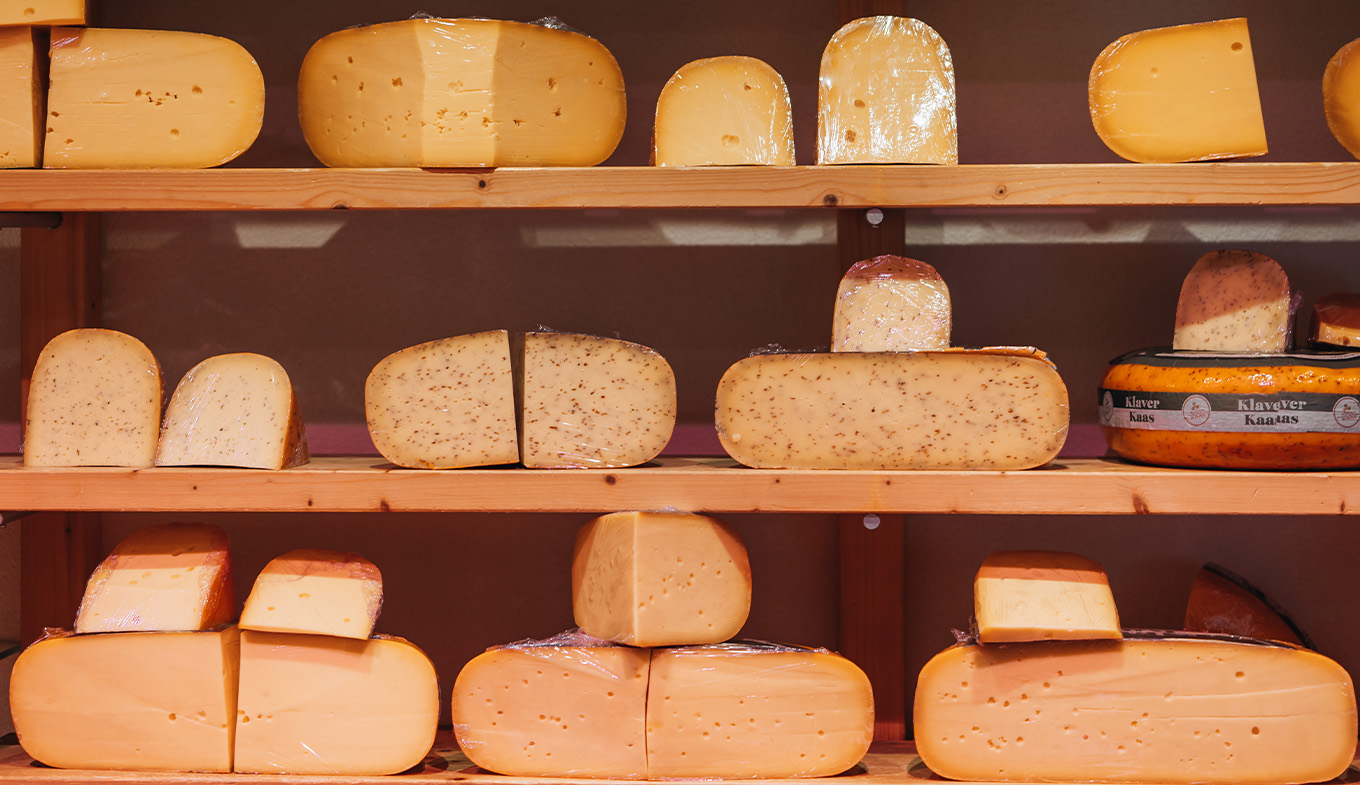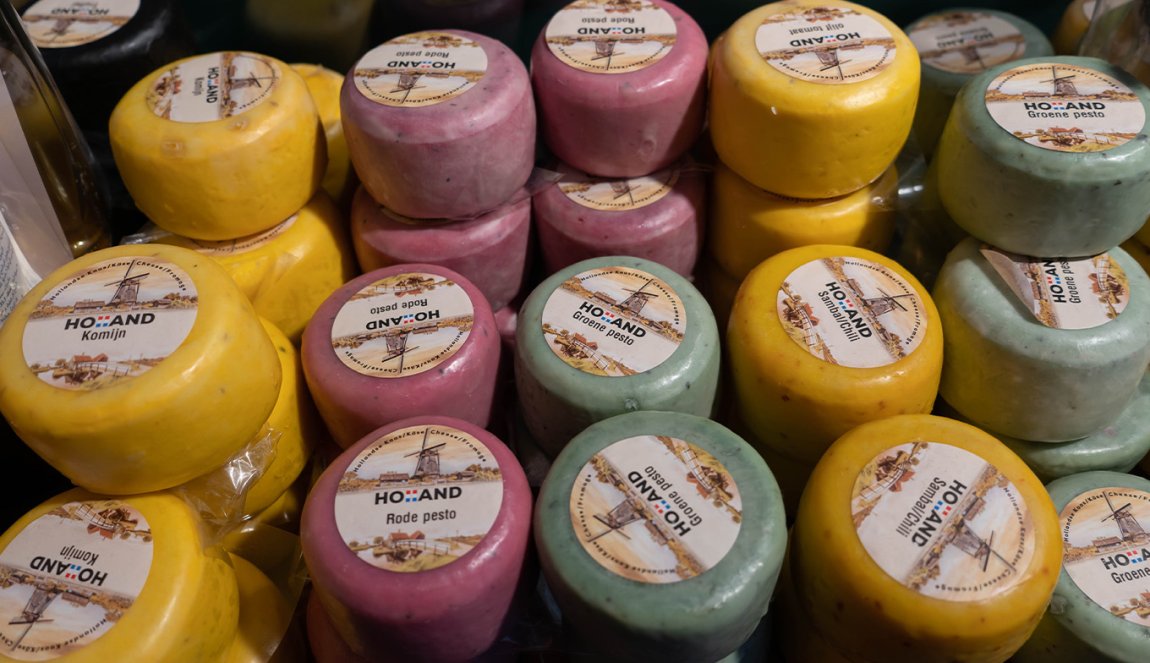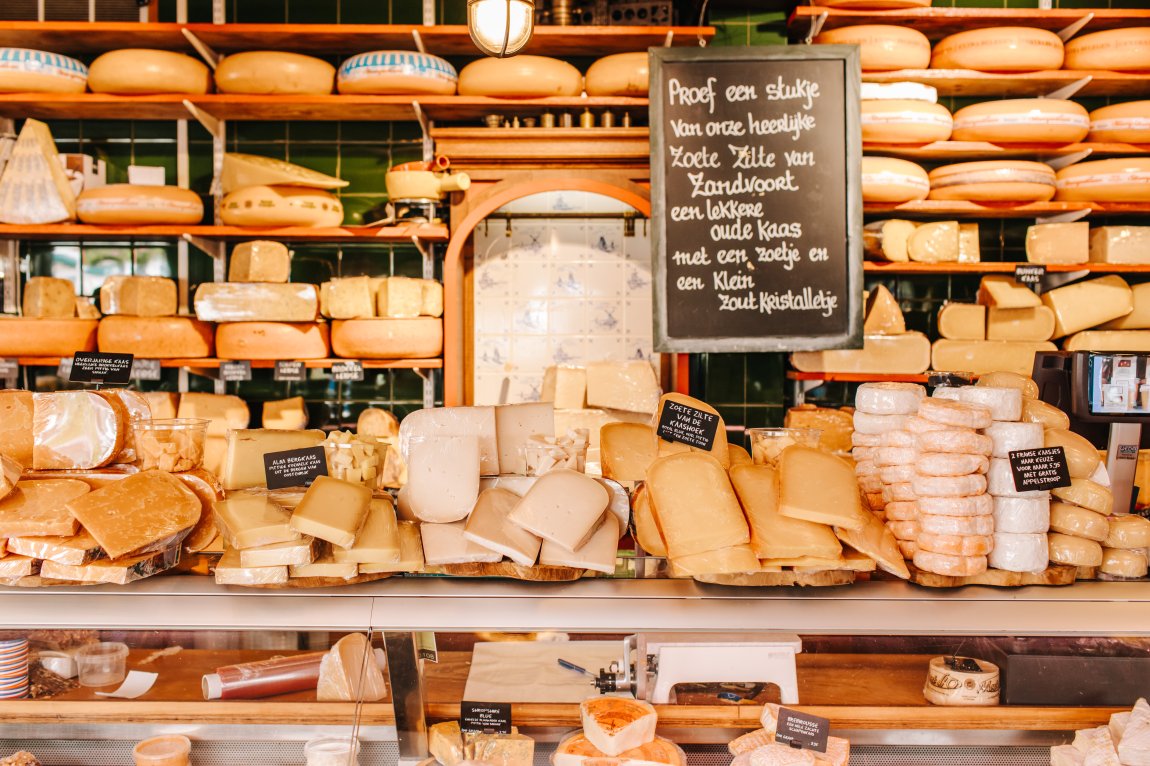
Cheese: the flavour of the Netherlands
Nothing is as famously Dutch as cheese. The association is so strong that a common nickname for the Dutch is kaaskoppen – literally ‘cheeseheads’. In this article, we explore the history behind the Dutch love for cheese. Join us in delving into the history of cheesemaking in the Netherlands and discover today’s cheesemaking culture, which puts an ever-stronger emphasis on sustainability. We also share some ideas and inspiration for places where you can join cheese tastings and learn more about this most Dutch of delicacies.
- Learn about the history of cheesemaking in the Netherlands.
- Get to know different types of cheese.
- Experience Dutch cheese at interesting locations.

A typical breakfast or lunch in the Netherlands both have one thing in common: bread and cheese. Cheese is an important part of daily life in the Netherlands and even of Dutch identity. But why is that?
The Dutch connection with cheese is not new. Archeological finds tell us cheese was already eaten here in around 800 BCE. Julius Caesar, too, noted that the Germanic peoples of the lowlands ate cheese. They prioritized livestock farming over agriculture. The reason for this was the land itself: too wet for growing most crops, but perfectly suited as pasture for cows.
In short, they’ve always made cheese in the Netherlands, because the Netherlands is made for cheese.
In the Middle Ages, dairy farmers began to produce cheese at a larger scale, and the first cheese markets were launched in Haarlem (1266), Leiden (1303), Oudewater (1326) and Alkmaar (1365). The cheese was sold and eaten in the Netherlands as well as abroad. Later, in the Dutch Era, Dutch cheese became increasingly popular internationally. Because the Dutch went everywhere, their long-lasting hard cheeses - such as Gouda and Edam - cheese became well-known and were taken aboard ships as food for the crews on long voyages.

Up until the early 20th century, cheese was made directly on the dairy farms. Cheese production then became more industrialized. But these days, there is also a resurgence of small-scale, artisanal cheesemaking, with a focus on animal welfare and sustainability. There are entirely plant-based Dutch-style cheeses available now. And small, organic farms, where cows still graze out in the fields, and which emphasize sustainable and ecologically responsible cheesemaking, aiming to show that the cheese industry can have a positive impact on pasture land, meadow birds and, of course, the cows.
Where to find (and sample!) the typically Dutch cheese?

The best-known Dutch cheeses are Gouda and Edam cheese. Internationally, all great yellow wheels of Dutch cheese tend to just be called Gouda, but there are actually many different types. Of course, there are young and mature cheeses, but there are also many local varieties, such as Stolwijk cheese, which is always made by artisans and from unpasteurized milk, and North Holland Gouda, which is registered as a protected designation of origin, and which has to made with milk from cows that graze on pastures in North Holland. There are also traditional cheeses with added flavourings, such as Frisian nagelkaas with cloves and Leidse kaas with cumin. These days, you can also buy nettle cheese, pesto cheese and even lavender cheese. Contemporary cheesemakers like to experiment to ensure their product stays exciting and new!
Many cheesemakers and specialized shops all over the country offer opportunities for cheese sampling. The Cheese Valley website lists cheesemakers and shops in the Groene Hart region, one of the most important regions for cheesemaking in the Netherlands. If you’re in the north of the country, head to Groningen for the cheese-tasting events at De Kaaskop – book in good time, as they are very popular.

In Utrecht and Amsterdam, check out the hip Kaasbar, where you can sample 24 Dutch cheeses that are offered with well-considered pairings – from quince jelly and smoked almonds to soy sauce and mango chutney – to complement their flavours. And if you’d like to visit a real, artisanal cheese farm, head for Kaasboerderij Weenink in Gelderland’s Achterhoek area. You’ll be able to see how their cheese is made, have a go at making some yourself, and, of course, taste the farm’s products. It’s a great activity to do with kids, too.
If you’re interested in learning more about vegan cheese, take a look at Willicroft and Those Vegan Cowboys, which are stocked in most Dutch supermarkets.
The traditional cheese experience
Alkmaar is a traditional destination for exploring the history of the Dutch cheese industry. Visit the historical cheese market, which takes place every Friday from April to September, and the cheese museum. If you are closer to Gouda – the town, not the cheese! – make sure to see the Goudse Waag, where you can see how the cheese traders used to weigh and trade the cheeses. There’s a cheese market here, too, and it’s surrounded by stalls selling other artisanal wares. One extra tip: Gouda is not just the home of cheese, but also of those irresistibly syrupy Dutch waffle cookies, stroopwafels. So there’s plenty on offer for all tastes.
Finally, you can eat your cheese like a Dutch person at home, too. Dutch cheese is available in many countries, and you can emulate the way the Dutch enjoy it by trying out the combinations that are common here, such as cheese and pickled pearl onions. Or sample some of the newer combinations, like mature Gouda with honey mustard, or strong cheese with pears or fig jam. The newest trend is cheese and chocolate… yes, the possibilities are endless.
